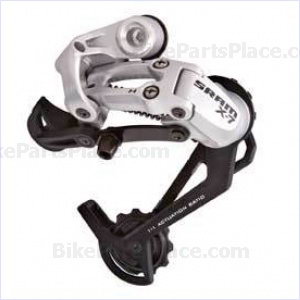 The SRAM X rear derailleur range, including the SRAM X.7, has a great reputation for offering great value for money, but without compromising on quality. Here we take a look at this rear derailleur in more detail, including what it is compatible with and the steps involved for installing it.
The SRAM X rear derailleur range, including the SRAM X.7, has a great reputation for offering great value for money, but without compromising on quality. Here we take a look at this rear derailleur in more detail, including what it is compatible with and the steps involved for installing it.
The Alloy SRAM X.7 rear derailleur is constructed from 6061 aluminum and a steel cage. The X.7 features outside facing limit screws with intuitive adjustment and sealed pulleys that can be easily serviced. It also features Di.R.T: Direct Route Technology™, 1:1 Actuation Ratio™, and SRAM’s Superior Shift Quality.
The medium version weighs 263 grams while the long version of the X.7 weighs 270 grams.
Compatibility
The Alloy SRAM X.7 rear derailleur is compatible with:
• SRAM1:1 Actuation Ratio Twist shifters
• SRAM1:1 Actuation Trigger shifters
• 11-28, 11-30, 11-32, 12-32, 11-34, 12-34, 14-34 cogsets
• SRAM Power Chain and Shimano® HG & IG
• 22-32-42/44, 24-34-46, 26-36-46/48 chainrings or 1.2 mm high quality cable
• 4 or 5mm compressionless cable housings with an end cap maximum diameter of 5.8mm.
Installing the SRAM Derailleur X
Installing the SRAM Derailleur X is not difficult if you follow the steps. However, before you start, check the rear derailleur hanger alignment. A bent rear derailleur hanger will result in inaccurate index shifting.
Firstly attach the rear derailleur to the frame’s rear derailleur hanger. Then, check that the b-adjust screw is clear of the rear derailleur dropout tab and tighten the hanger bolt.
Next, shift the chain to the small chain ring and turn the crank and push the rear derailleur inward to the largest cog. Then, hold the rear derailleur in this position while turning the b-adjust screw until the chain gap equals approximately 6mm from tip of the cog to the tip of the upper guide pulley. While pedaling, release the derailleur and check the chain gap throughout the cassette.
Next, check that the chain and the rear derailleur are in the smallest cog position, then measure and cut the rear cable housing, making sure it isn’t too short or too long. Then, rotate the rear shifter to the largest number and gear indication.
After you’ve done this, turn the rear shifter barrel adjust clockwise fully into the shifter, then back it off one full turn. Feed the rear shifter cable through the rear derailleur cable housing, stops and cable guides and thread the rear derailleur cable through the rear derailleur housing and the stop and then through the cable guide on the fin. Then pull the cable tight and position it under the cable anchor washer. Tighten the cable anchor bolt and shift the chain and derailleur up and down the cassette.
Then you shift the chain to the smallest cog and inspect the rear derailleur and pulleys from behind the rear wheel. Turn the limit screw on the outer link of the derailleur to align the upper guide pulley center with the outboard edge of the smallest cog.
After you’ve done that, turn the crank, and push the rear derailleur towards the larger cogs. Then, align the upper guide pulley under the largest cog, center to center, by turning the limit screw marked on the outer link.
Finally, while turning the crank, shift the chain up and down the cassette and chain rings several times to ensure that your derailleur is changing smoothly.
There you have it, it’s really quite simple, if you follow the steps properly. Of course you will receive much more detailed instructions when you purchase the SRAM X rear derailleur.
Tags: sram rear derailleur


 Shopping
Shopping



Thank you for some very easy to understand but thorough instructions. That’s kind of hard to find in an online article sometimes. The SRAM derailler does sound like a quality product. A tough aluminum alloy with less working parts in it has got to be a good idea. I bet I’ll be checking one out the next time I need one.